
http://www.iaeme.com/IJM/index.as 246 editor@iaeme.com
International Journal of Management (IJM)
Volume 8, Issue 2, March– April 2017, pp.246–259, Article ID: IJM_08_02_027
Available online at
http://www.iaeme.com/ijm/issues.asp?JType=IJM&VType=8&IType=2
Journal Impact Factor (2016): 8.1920 (Calculated by GISI) www.jifactor.com
ISSN Print: 0976-6502 and ISSN Online: 0976-6510
© IAEME Publication
PROJECT MONITOR & CONTROL THROUGH
MANAGEMENT BY EXCEPTION-A
FRAMEWORK FOR SOFTWARE INDUSTRY
Syed Abdur Rahim Md Muinul Islam
MSCSE, United International University, Dhaka, Bangladesh
Dr Hasan Sarwar
MSCSE, United International University, Dhaka, Bangladesh
ABSTRACT
A project is a temporary endeavor undertaken to create a unique product, service,
or result based on specific requirements and expectation of customer. The temporary
nature of projects indicates that a project has a definite beginning and end. A project
is driven by “triple constraints” Scope, Time and Cost which deliver a defined quality
product or service in order to succeed, a project must deliver to cost, to quality, and
on time; and it must deliver the benefits presented in the business case. The effective
implementation of Management by Exception (MBE) for every efficient use of
management time as it reduces managers time burden without removing their control
by ensuring decision are made at the right level in the organization. The project has
defined tolerances for each project objectives to establish limits of a delegated
authority. The tolerance is a permissible deviation above and below a plan’s target for
time and cost without escalating the deviation to the next level of management. The
success of the project depends on effective monitoring and controlling of tolerance
level of project’s parameters to identify the root causes of the issues and properly
address these in timely manner.
Key words: Capability Maturity Model Integration, Constructive Cost Model II, Cost
Performance Index, Functional Point Analysis, Goal Question Metrics, International
Organization of Standards, Key Performance Indicators, Organizational Measurement
Repository, Strength Weakness Opportunity Threat.
Cite this Article: Syed Abdur Rahim Md Muinul Islam and Dr Hasan Sarwar, Project
Monitor & Control Through Management by Exception-A Framework For Software
Industry. International Journal of Management, 8(2), 2017, pp. 246–259.
http://www.iaeme.com/IJM/issues.asp?JType=IJM&VType=8&IType=2

Syed Abdur Rahim Md Muinul Islam and Dr Hasan Sarwar
http://www.iaeme.com/IJM/index.as 247 editor@iaeme.com
1. INTRODUCTION
To achieve the mission critical and time driven business objectives, project management has
become a central way for undertaking several of the business activities. The lack of
monitoring and controlling tools is one of the increasing and most significant concerns with
projects is that, projects are behind schedule, over budget and show unsatisfactory
performance in terms quality and customer satisfaction. The “triple constraint”[1] impact the
project schedule, cost and scope to deliver the specific product and services as per
requirements. In a perfect world every project would be "on time and within budget." But it’s
not uncommon for projects to fail. A project is considered a failure when it has not delivered
what was required, in line with expectations. Project requires to establish the measurement
repository for matrices which present the status of project indicators for evaluation. The main
challenges are the identifying the key indicators of the projects and how to extract the data to
represent management for decision support. The thesis will work for design a framework to
supervise the project with quantitative analysis where tolerances are deviated and evaluate the
project through management by exception.
There are a few global standard models are available in the industry such as CMMI,[2]
ISO[3], Six Sigma[4] to implement the process to achieve successfully improved quality and
productivity, by using the concepts of process management. The thesis explores the relevance
of quantitative analysis of project metrics in project management and how the framework can
establish the repository with the underlying key indicators by following the tolerance level to
support decision making process through management by exception.
The purpose of this thesis is to develop the framework[5] of project monitoring and
controlling tools for software industry that basis on underlying quantitative indicators and
evaluate management by exception for improving project productivity.
2. LITERATURE REVIEW
To define the metric of the projects, there are some global standards like GQM, SWOT
analysis to monitor and evaluate the project. The below techniques are explore to review the
metrics process:
2.1. Software Measurement Technique and Review
The measurement process must be integrated into the software lifecycle processes. The phases
determine the opportunities for measurement. Because the software process itself, is dynamic-
the measurement process also must change and adapt as the program evolves. The major
reasoning for measuring software process, products and resources to characterize, evaluate,
predict and improve the product quality and process performance. The techniques of deriving
measurements and metrics of the software project apply by Goal Question Metrics (GQM),
Historical Data from Organizational Repository and SWOT Analysis. The
Goal/Question/Metric (GQM)[6] standard affords a framework for deriving measures from
measurement goals. The idea is to define a measurement goal with five dimensions as Object
of Study, Purpose, Quality Focus, Point of View and Environment. The SWOT[7] Analysis is
a very useful tool for decision making and for organizing ones thinking about a certain
situation or idea, whether that is a company’s current situation, a certain problem within a
company’s process and measures the specific indicator to achieve the goals. The technique
focuses on the identification of strong and weak points within an organization and the analysis
of opportunities for, and threats to, further development. The Expert Judgment from historical
data also derives the measurement indicators for the projects. These are identifying the entity,
attribute and measures of the projects to monitor and control.

Project Monitor & Control Through Management by Exception-A Framework For Software
Industry
http://www.iaeme.com/IJM/index.as 248 editor@iaeme.com
2.2. Goal Question Metrics
The Goal Question Metric (GQM)[8] approach is based upon the assumption that for an
organization to measure in a purposeful way it must first specify the goals for itself and its
projects, then it must trace those goals to the data that are intended to define those goals
operationally, and finally provide a framework for interpreting the data with respect to the
stated goals.
The goal-driven process[9] begins with identifying business goals and breaking them
down into manageable sub goals. It ends with a plan for implementing well-defined measures
and indicators that support the goals. Along the way, it maintains traceability back to the
goals, so that those who collect and process measurement data do not lose sight of the
objectives. It clearly defined measures that can be implemented and applied consistently in r
organization, in ways that directly support business goals. Table 1 provides the process steps
as follows:
Table 1 Process steps
SL Steps
1 Identify your business goals.
2 Identify what you want to know or learn
3 Identify your sub goals
4 Identify the entities and attributes related to your sub goals.
5 Formalize your measurement goals
6 Identify quantifiable questions and the related indicators that you will use to help you
achieve your measurement goals.
7 Identify the data elements that you will collect to construct the indicators that help
answer your questions.
8 Define the measures to be used, and make these definitions operational.
9 Identify the actions that you will take to implement the measures
10 Identify the actions that you will take to implement the measures
2.3. SWOT Analysis
SWOT[7] is used as a tool for exploring the constraints and opportunities of a project
proposal. It can be used to test the completeness of a goal. Strengths and weaknesses refer to
those strengths and weaknesses within the project. Opportunities and threats refer to the
opportunities for, and the threats to, the project in respect to achieving the goal. To identify
the measures from SOWT, the qualifiers of each SWOT attributes are quantifying with the
means of units which can be added in the OMR to monitor and control of the project. The
below is the model of SWOT Analysis:

Syed Abdur Rahim Md Muinul Islam and Dr Hasan Sarwar
http://www.iaeme.com/IJM/index.as 249 editor@iaeme.com
Figure 1 SWOT analysis
The SWOT can be categorized in four elements and define the unit to measure the specific
attribute of the component. The below table figure out the process of identifying the
measurements of the project as sample basis:
Table 2 Measurements of the project
Element Strength Weakness Opportunity Threat Metrics
People Certified and
Professional
Employee
Leaving the
company is
very fast
Brand
Value
Exclusivity
of the
products
Exclusivity
Regulations
Taxation
policy
% of Certified
& Professional
Out turn Rate
of employee
Process Defined SOP Un updated
documents
Nos of artifacts
implemented
Nos of Non
Compliance
Technology Establish state
of the arts
technology with
tier III data
center
Power
interruption
NosTechnical
Issues
Occurred
Rate of power
failure
Environment User friendly
work
environment
with
multicultural
aspects
Flat
Management
creates
conflict of
interest
% of
environmental
issues occurred
2.4. Metrics Uses in Software Projects
The software project’s metrics are identified based on the characteristics and criticality of the
project features. The common and mostly used metrics are:

Project Monitor & Control Through Management by Exception-A Framework For Software
Industry
http://www.iaeme.com/IJM/index.as 250 editor@iaeme.com
Table 3 Software project metrics
Metrics Definition Methods & Tools
Size Software size is widely recognized as an
important cost driver for the effort and cost
needed for software projects
Functional Point Analysis
(FPA)
Effort Effort estimation is the process of predicting the
most realistic amount of effort (Person-
Hours/Day/Month or money) required to develop
or maintain software based on requirements, risks
and constraints.
Constructive Cost Model
II (COCOMO II)
PM Nominal = A x
(SIZE)B
Here,
PM = Efforts in Person
Months
A = the constant, used to
capture the multiplicative
effects on efforts with
projects of increasing size
SIZE = the unit of
software requirements
Functional Point (FP) or
thousands of source of
lines of code (KSLOC)
B= accounts for the
relative economics or
diseconomies of scale of
software projects of
different size.
B= 1.01 + 0.01∑Wi
W= summed across all of
the factors, and used to
determine a scale
exponent B
Schedule It measures the duration of the projects End Date minus Start
Date
Defect
Density
Defect Density is the number of defects confirmed
in software/module during a specific period of
operation or development divided by the size of
the software/module. It enables one to decide if a
piece of software is ready to be released.
Nos of Defects/Size
Nos of
Change
Request
Number approved change request (CR) occurs
after baseline scope or requirements
Numbers of CR
Project Budget at completion (BAC) is the original cost EVM


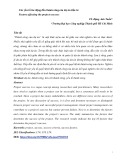
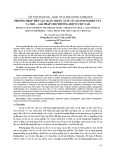


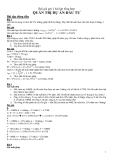

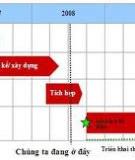

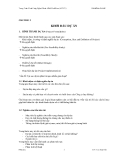
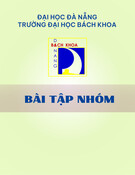






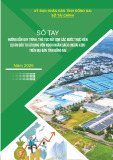
![20 câu hỏi Quản lý dự án phần mềm có đáp án [mới nhất]](https://cdn.tailieu.vn/images/document/thumbnail/2025/20251003/hieu2004haha@gmail.com/135x160/78791759734259.jpg)
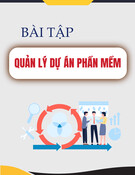

![Tài liệu Quản lý dự án: Kiến thức nền tảng toàn diện [chuẩn SEO]](https://cdn.tailieu.vn/images/document/thumbnail/2025/20250910/kimphuong1001/135x160/92631757496585.jpg)



